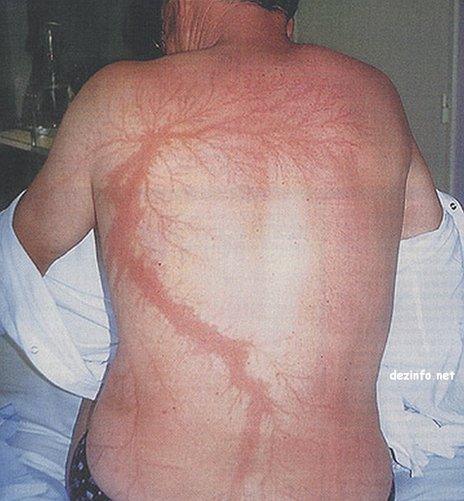How do you recover from being struck by lightning?
- Published

Summer storms often result in thunder and lightning. Every year a small number of people die from being hit, but what about those who survive?
Lightning is a discharge of static electricity that occurs when there is an imbalance in the electrical charge between the cloud and the earth's surface.
Put very simply, it is a giant electric spark in the sky - a very powerful one. It can stop a person's heart and cook their internal organs.
On average three people die in the UK each year from lightning strikes, according to the Royal Society for the Prevention of Accidents (Rospa). In the US, deaths have been in decline, external but are still in the region of 30 a year. More than 85% of those killed are male.
In the UK, up to 60 people every year get struck and survive, but it's estimated that more than three-quarters of them suffer some form of permanent disability.
So what is life like after being struck by lightning?
Eric Brocklebank, then 64, was struck on 9 June 2009 as he boiled sausages for a group of cadets at an event at RAF Digby.
He had just removed a metal barbecuing prong from the water and was holding it in the air when the strike happened.

Lightning bolt injuries typically leave distinct burns on the skin

"A bolt of lightning came straight through the gap in the tent. It hit the fork I was holding. That melted into my hand."
With lightning strike victims you can sometimes guess at the path of the electricity because of the formation of a Lichtenberg figure. Sometimes known as "lightning tree" or "lightning flower", these intricate, fern-like patterns are caused by capillaries bursting.
In Brocklebank's case, the lightning first caused a small wound in his wrist.
"Then it went down the right side of my body, across my hips and down through my left and right legs. It blew three holes in my right foot and two holes in my left foot."
He was lucky to be surrounded by people who were able to help.
"As luck had it, all of the cadets knew CPR. One of the first people down there was my son. The first responders then worked on me for 20 minutes."
More than three-quarters of lightning survivors suffer some form of permanent disability.
For Brocklebank, the consequences, four years after the strike, are both physical and mental.
He has scar tissue on his lungs and can be easily left short of breath. Sometimes his mobility is fine but occasionally he has to resort to a wheelchair. He is grateful for all the doctors and nurses who have worked on him over the years.
"I've had numerous exploratory examinations. I try to put a brave face on it. I'm not a person who lets things get me down." He has retired from his job as a designer of X-ray systems, but still occasionally works. On one hospital visit he was told: "We don't normally treat people with so many different problems."
Men are four times as likely to be struck as women, says Rospa. This is believed to be because men are statistically more likely to be outdoors. Golfers are probably at greatest risk, because they are likely to be caught in the open far from shelter.
There are three types of lightning strike. A direct strike is when it hits you and goes to earth through you. A side flash is when it hits another object and jumps sideways to hit you. A ground strike is when it hits the ground then travels through it hitting you on the way.
Most people understand the dangers of being on open ground on water or near trees during the height of the storm. But there can still be danger before the storm is apparent and after it appears to have finished.
Most alarmingly, Brocklebank recounts how his house was later struck by lightning, damaging his television and causing him to be treated for shock. He is understandably anxious in stormy weather.
"I'm told lightning only strikes once. I'm told it's an act of God," he says.
You can follow the Magazine on Twitter, external and on Facebook, external